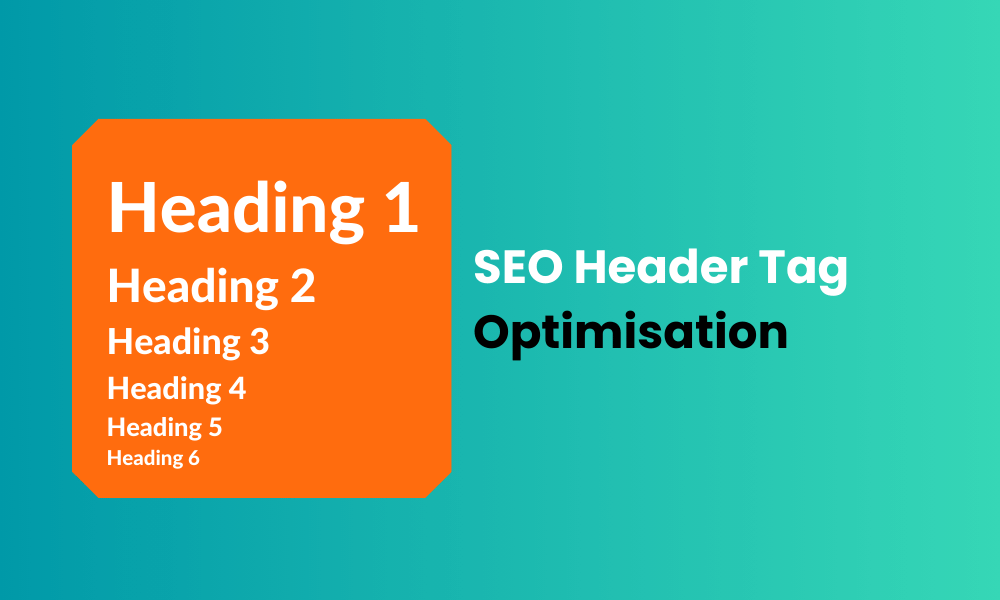
How to maximise the value of header tags for eCommerce
Table of Contents
Header Tags present the visitor a clear picture of the page content of your online store. These tags also make your eCommerce store look professional and organised.
Search Engine algorithms follow a set of rules or calculations that give enormous importance to site structure and header tags form an important part of that map.
As a result, header tags are essential for both human comprehension and Search Engine bots, and play a crucial role in eCommerce SEO.
In this detailed Header tag SEO guide, I’ll cover the basics, real-world examples, mistakes to avoid and other useful tips.
What Are Header Tags and How Many Are Supported By HTML?
Header tags are HTML (Hypertext Markup Language) elements. They define the headings of a web page on your eCommerce store.
There are six header tags, and they separate the main page heading <h1> from the other headings <h2> to <h6> in the remainder of the content.
Header tags typically rank in order of importance – H1 to H6.
- H1 tag is most critical on your eCommerce web page. You should not skip the H1 tag on any of the pages of your eCommerce store.
- H2 and H3 are next in order of importance and are usually reserved for Headings and Sub-headings on various Site Pages.
- H4, H5, and H6 are further down the value chain and should be used to organise less important yet relevant content on blog posts and lower priority text.
What Is The Difference Between the Title Tag and H1 Tag on a Page?
In terms of HTML, a Title Tag is indicated as Title. The H1 tag is indicated as h1.
Since both of them serve as titles to explain what your page is about, a lot of site owners mistakenly think they are the same.
It’s true that your Title Tag and H1 Tag have a lot of similarities. But they have some important differences too.
A title tag is the text that prominently appears below the URL in Google search results. It’s the text that a visitor will see while browsing Google, before they click on your page result.
Please note that while Title Tags show up in search engines, it does not show up on your actual results page. Conversely, while H1 Tags DO NOT show up in search engine results, they show up on TOP of your page.
An example of a Title Tag is shown below:
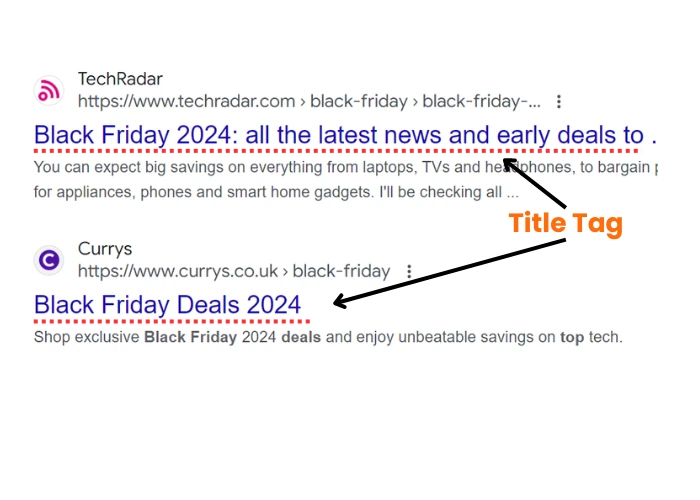
An example of an H1 Tag is shown below:
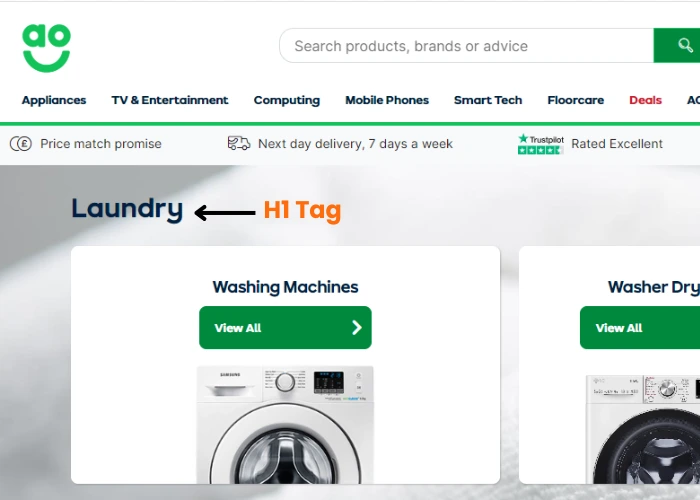
Header tags are a vital factor in ecommerce SEO as they help Google understand what your online store is about. Include relevant HTML tags for your ecommerce pages.
The most appropriate Title and H1 Tags also help Google understand the most important aspect of every page on your web store.
Shown below are three examples of web pages of top eCommerce websites in the UK.
You can see that they use specific title tags that describe the products they sell. Even a casual visitor will quickly understand everything that the ecommerce store sells.
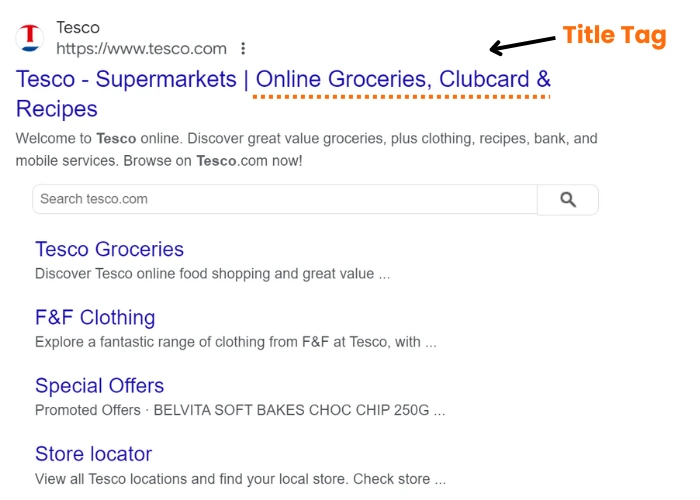
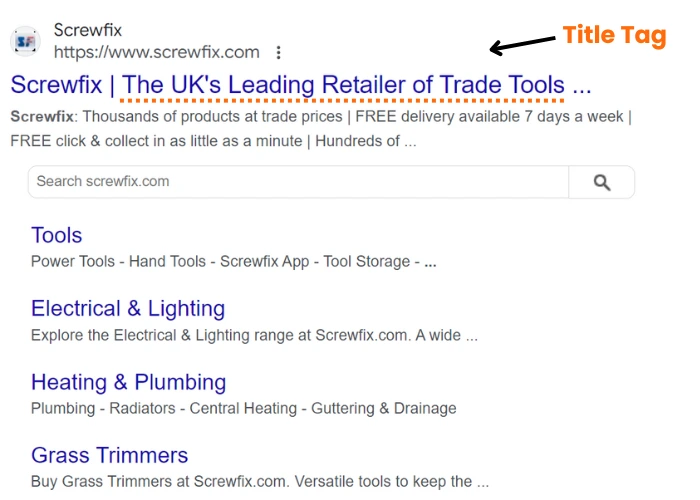
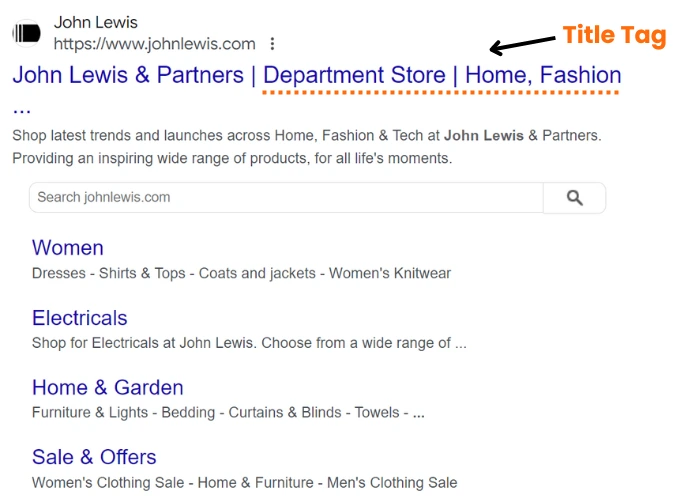
What is the Importance of Header Tags to an Ecommerce Site’s SEO?
1. Header Tags Provide Semantic Structure to a Page
Unfortunately, 90.63% of web pages don’t get any organic traffic from Google. These websites have not been optimised for search efficiency including not being updated with relevant HTML elements.
Hyper Text Markup Language (HTML) is the foundational block of the web. It provides structure and appropriate context to different sections of a web page. This is also referred to as Semantic Structure and makes a web page more understandable for the browser, the developer and the search engine.
Without proper header tags, search engines may not find these pages to be relevant. Moreover, visitors are unlikely to discover such sites.
Semantic HTML clearly defines the elements on a webpage, making the overall page more understandable. For an online ecommerce store, this means that search engines understand different parts of your pages better.
IMPORTANT NOTE: Ensure you avoid keyword stuffing in your header tags. Its a spammy practice with a high probability of algorithm penalisation.
2. Header Tags Help Make Your Content More User-Friendly (Across Devices)
For internet users, large chunks of text can be both overwhelming and boring to read. By utilising header tags, you can break down content structure and improve readability.
If your content is broken into shorter paragraphs, with appropriate subheadings/header tags, you can keep a reader on the page for longer.
Finally, if users stay on your pages for longer, search algorithms will reward your page by continuing to rank it higher.
Pro SEO tip: Use a hierarchical header tag structure, without skipping hierarchies. For example, don’t put <h3> tag above an <h2> tag.
3. Header Tags Allow You To Stagger the different headers based on importance
H1 Tags are reserved for the title of your web page. They are usually important stand out headings.
H2, H3 and lower level tags (h4,h5, h6) are used to structure the content on a page, in order of importance.
For example, in one paragraph, you could have an h2 header tag followed by an h3 tag and multiple h4 tags.
Next, in a new topic paragraph, you could have another h2 header tag followed by nested h3 and h5 tags.
So, ideally, you should have the HTML tags for ecommerce organised by their content, relevance and importance.
Below is an example of Staggered header tags in an eCommerce Online Store, selling nutritional supplements. Observe the heading structure in which various tags have been organised:
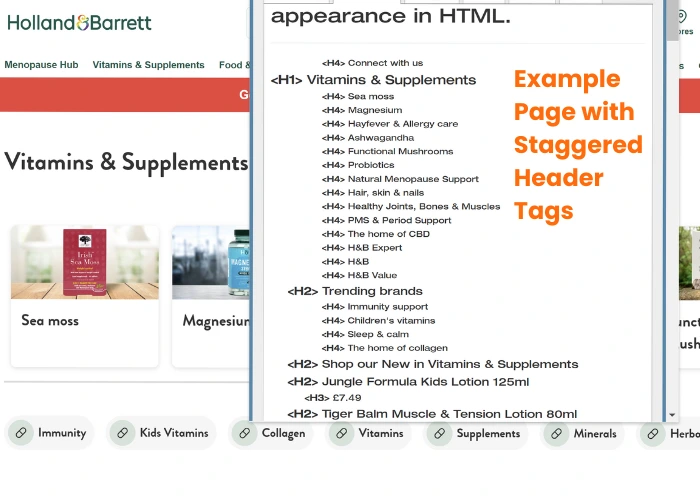
4. Header Tags Help Optimise for Rich Results Such as Featured Snippets and People Also Ask (PAA) Boxes
Featured Snippets
A Featured Snippet, also referred to as Position #0, is a tiny snippet of text that appears at the top of the search results in Google, for informational queries. This snippet provides a quick answer to the searcher’s query. Shown below is an example of a Featured Snippet:
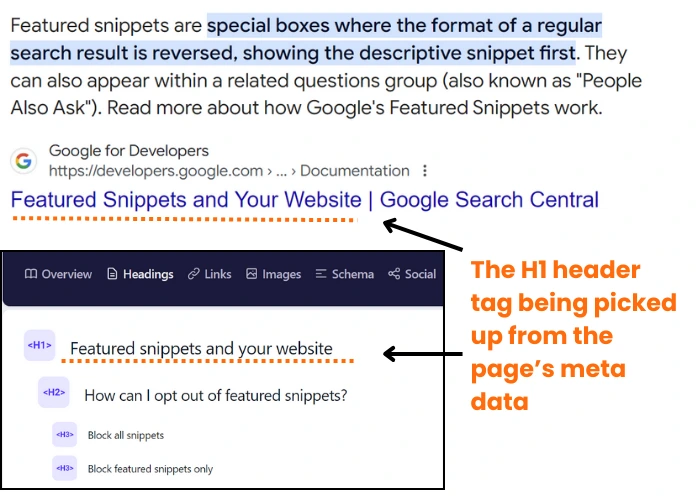
Definitions, steps, lists and tables are the common types of Featured Snippets.
A simple way to increase organic traffic to your online store is to win more featured snippets. And some of the ways to optimise your content for Featured Snippets are:
- Using questions being searched for as Header tags
- Leveraging existing content, specifically the content you already rank for
- Using simple language and short sentences
- Breaking the content down to bullet points and short paragraphs
People Also Ask (PAA) Box
A People Also Ask (PAA) box, a Google SERP feature, answers a question related to the searcher’s query, and auto-features additional questions based on machine-learning algorithms.
Shown below is an example of a PAA box. Note that the Search Engine not only answers your initial question about “People Also Ask Boxes” but also anticipates your next queries by providing a helpful list of related questions.”

The step by step method to optimise your content for PAA boxes include:
- Find web pages that rank for several keywords
- Pull out keyword rankings
- Scrape PAA results
- Look for the most asked PAA questions
- Check your website’s eligibility to rank in the PAA box
- Optimise your content for the PAA questions
- Ensure you are not the source already
5. Header tags provide Future Potential for Voice Search Queries
Voice search is growing rapidly because it’s much faster than typing.
Voice search queries are typically longer than conventional searches on mobile devices and laptops are. They are also more conversational.
Before examining the future potential for voice search queries in detail, let us look at the basics of how Google bots work.
- Search engine bots index web pages. They store the underlying HTML code on the search engine’s servers during this process.
- The HTML tags for ecommerce are then analysed and interpreted by the algorithms of the search engine. This way, search queries get matched instantaneously.
Here, your header tags become a vital piece of code, as search engines assess them when they determine the keywords the content on your online store should rank for.
They also assess how the content on your web pages is organised and the sort of products your ecommerce store sells.
Voice controlled assistants such as Google Assistant, Siri, and Alexa can mainly provide answers to search queries in two ways:
1. They will state the answer to a question based on phrase match of top search results
2. Provide the site or resource where you’re likely to find the answer to your question
Voice search is used more often these days for simple informational queries such as “How high is Mount Everest?” as well as hyper local search queries such as “pizza joints near me”, or “navigate to the Ikea Store in…”.
Such searches have a very high commerical intent, so optimising your page meta tags appropriately can give you an edge.
Some ways to optimise your header tags for voice search queries:
- Researching the top keywords that potential visitors use in their conversational queries related to your industry and products
- Targeting long-tail keyword phrases – especially questions, and answering those questions
- Update and Optimise your Brand’s Google Business Profile to capture hyper local searches
What is the Ideal Heading Tag Structure for Ecommerce Sites?
Home Page Tags
Structure the Home Page Header tags in the order of semantic layout and commerical importance (of certain keywords), for your Brand.
Shown below is an example of a highly ranking homepage of an ecommerce store – Johnlewis.com.
The page’s heading structure begins above the fold (part of the page visible to a site visitor when they first land on the page) with H2 tags for the latest promotional deals and H3 tags for the product titles.
As the user scrolls down, the page utilises several H2 and H3 tags to structure the remaining content.
Sometimes, tags are auto-assigned based on a specific CMS (Customer Management System), rather than by an SEO professional/team.
Despite less than optimal Header tag structurs, several Ecommerce giants rank quite high since they have massive Brand authority.
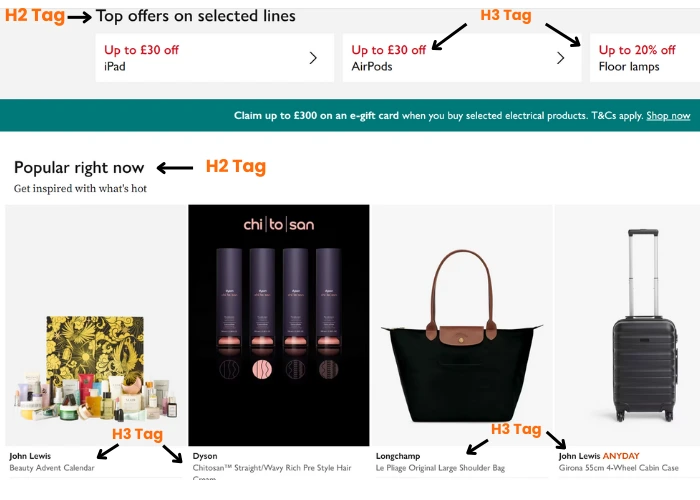
Category Page Tags
Improving category pages is crucial as they’re the most likely to rank for transactional searches.
When you ensure your category pages are straightforward and easy to navigate, your customers will be able to find the product they want to buy easily.
Shown below is a Category Page on the FurnitureBox Online Store.
The page’s heading structure, marked in black, consists of an H1 tag for the category title, an H2 tag for brand FAQs, and H3 tags for subcategory titles.
While other header tags are present, the H1, H2, and H3 tags are considered most important for optimisation.

Below is the Header Tag structure for the perfume category on UK’s leading Luxury Store, Harrods.

Product Page Tags
Product images and header tags are important aspects of your eCommerce product page. For a physical product, this is especially so.
The Holland & Barrett Online Superstore product page uses an H1 tag for the product name, H3 tags for product details – product description and additional information.
Interestingly, their product page doesn’t use the header tags in sequence, skipping H2 tags entirely.

Below is another example of a product page from Patagonia, a retail fashion brand. The page has a more sequential header tag assignment – H2 tags are used for the main section of their product page and H3 tags are used for the sub-section.

How Many Times Can You Use Each Header Tag on a Single Ecommerce Site Page?
H1 Header tag Frequency
Use only one H1 tag per webpage.
If you’re not sure about the page having an H1 header tag, verify it using the page’s source code or ‘Inspect’ element.
Why use only one H1 tag?
Multiple H1 tags on a single page will harm visual appeal and user experience. They will also dilute page quality and may confuse search engine crawlers.
H2 header tag Frequency
H2 tags add semantic richness to your ecommerce web page.
This helps the search engines to understand the makeup of your web page. Also, visitors find it easy to navigate through your store, as they can move from heading to heading.
The frequency of H2 tags on a web page is largely dependent on the structure of your web page content.
Since keeping the content concise is an important aspect of an eCommerce store, you will need either one, two, or three H2 tags on a Top-level Page, though this number will vary on Pages with several Products or a huge amount of content (such as Blog articles).
H3 Header Tag Frequency
Use H3 tags to provide structure to your content and break up copy.
Unlike the H1 tag, there is no fixed limit to the number of H3 tags on one page. While you can have as many H3 tags as you want, don’t fill your content with them. The idea is to present your web store visitor with a great on-page user experience and keep them on the page longer.
The best practice is each one of your H2 tags can have multiple multiple, nested H3 tags. Ensure that you have the header tags in sequence – for instance, h1, h2, h3, h4 and so on. Make certain you don’t skip the h3 tags entirely – for instance, h1, h2 and h4.
H4, H5, H6 frequency
You probably don’t need to drill details down past H4 tags on your ecommerce store. But if you need to do that, you can do that in the right sequence. It’s helpful for ecommerce SEO. And that’s the reason there’s a hierarchy in the importance of header tags – from H1 to H6.
It’s helpful for ecommerce SEO. That’s the reason there’s a hierarchy in the importance of header tags – from H1 to H6.
What Are Other Header Tag Best Practices?
In addition to the ideal heading tag structure and frequency of use, there are some advanced heading strategies that you should consider:
1. Target Keywords, Concise Language and NO Keyword Stuffing
Add relevant focus keywords into your header tags to improve page visibility. Also, prioritise clear, informative and engaging header tags to improve user experience.
Let’s take an example:
- Good H2: “How to Clean Whirlpool Bath Jets?”
- Bad H2: “Here’s a Detailed Guide on How You Can Easily Remove Dirt and Other Debris from Your Whirlpool Bath Jets”
Finally, avoid keyword stuffing. This practice makes your content low-quality/spammy and makes it unpleasant to read.
2. Use Synonyms And Variations Of Keywords
Google understands semantic relationships between keywords. Therefore, when adding headers with keywords, instead of repeating the exact keyword, use variations and related terms.
Using synonyms, variations and secondary keywords in header tags can help rank your content for related terms.
3. Don't Use Headers for Styling
The purpose of header tags is to provide logical structure to your content. Therefore, don’t use header tags for styling text.
If you want to increase the font size for specific text, use CSS instead. Let the headers serve their proper function in content organisation.
Header Tag Mistakes You Should Avoid
1. Not Using Headings at All
I know this sounds weird, but there are times when pages lack any heading tags, they rely solely on body text to build content.
This is a problem because, without headings, the content you create lacks structure. This also makes it difficult for users and search engine bots to understand your content.
2. Skipping Heading Levels
Applying header tags out of order can be confusing for search engines. For example, after H1 you jump to H3. Remember, the purpose of header tags is to create a logical structure for your content.
Follow a logical order in your heading tags (H1 > H2 > H3, etc.). In fact, Google recommends using a hierarchical order.
3. Overusing or Underusing Headings
Aim to create a balanced content structure with well-structured headings. Too many headings can make the content harder to follow, while too few can make the page difficult to scan.
Use headings to guide the reader and break down the text into digestible sections.
FAQs About Header Tags
How to Add Header Tags in HTML?
HTML (Hypertext Markup Language) is the code used for developing web pages. You can learn some simple tags easily, and they’ll be helpful in optimising the ecommerce SEO of your store.
To add an H1 tag in HTML, you’ll need to type in <h1> and </h1>, placing the H1 text in between the two tags.
For instance, if your H1 is Best Practices for Adding HTML Tags in Ecommerce, you’ll need to type in:
<h1>Best Practices for Adding HTML Tags in Ecommerce</h1>
The process is the same for adding other header tags, as well.
Depending on your ecommerce CMS platform, click on the relevant link to learn how to add header tags
Do All HTML Tags Need to be in Sequence, i.e., H1 Followed by H2 and so on?
W3C page-structure guidelines suggest nesting headings by their ranks (h1>h2>h3>h4>h5>h6) within a specific section.
Use headings with the same or equal rank to start a new section, and headings with a lower rank to start a new sub-section within the higher section.
That being said, it’s ok to skip ranks when switching sections. For example, an <h4> tag in one section can be followed by an <h2> tag in a new section.
Sometimes, depending on the theme and template of your web page, you may need to adjust the header tags.
While H1 is the primary heading, there’s nothing wrong in starting a page with H2, as long as you have the Title of the Page covered (which defaults to an H1 based on HTML rules).
Is it OK To Use Emojis in Header Tags?
HTML emojis are Unicode* characters with numerical values (decimal or hex).
While it’s ok to use emojis in header tags, prioritise keywords at the beginning of header tags for SEO.
In my opinion, emojis are best used at the end of header tags. While visually engaging, they offer no SEO benefit.
*Unicode is a universal character set that breaks down all the characters needed for writing the majority of programming languages in use on computers.
Header Tags: Final Thoughts
The primary goal of an online store is to maximise top-line revenue growth for the products they sell.
An SEO failure – specifically, the failure to maximise the value of header tags on your online Store – can result in lower search visibility, fewer online store visits, fewer conversions, and finally lost revenue.
Therefore, strengthening the HTML tags for eCommerce will help you attract more relevant organic traffic, achieve a higher conversion rate and maximise your fullest business potential.
If you’re a retail eCommerce Business, looking to maximise the value of ecommerce Header tags on your online Store, do get in touch with me for a 20-minute SEO discovery meet.
Liked The Article? Share It

